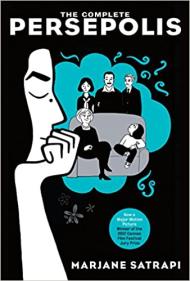Welcome to the Women for Women International Book Club! This month, we're reading The Complete Persepolis by Marjane Satrapi.
An autobiography, The Complete Persepolis brings together both volumes of Satrapi's graphic novels, Persepolis 1 and Persepolis 2, following the author's life starting with a childhood during 1979 Iranian Revolution into her adulthood. Since the first volume's publication in 2000, the graphic novels have received multiple awards, eventually becoming a critically acclaimed animated film.
What is The Complete Persepolis about?
In stark black and white illustrations, Satrapi delivers a coming-of-age story amidst a backdrop of violent political upheaval and the Iran-Iraq War. During her childhood, Satrapi's parents cultivated her intellectual curiosity, political mind, and independence. Satrapi's illustration and storytelling intersperse humor with the growing repression from those who would twist faith into a cudgel for power. As the tides changed in their society, her boldness and need to question the status quo signaled a need for change from her parents. With love, they sent her to study in Vienna.
For the adolescent Satrapi, Europe proves to be a different kind of oppression: isolating and Othering. After failed friendships and relationships, Satrapi returns home to an Iran of public and private contradictions, and strives to reconnect with her family and friends. She continues her studies and reclaims her voice and direction, before heading to France.
Persepolis continues to be a classic view at how war and violence change a society, and become an opening for those who would seek to exert power over others to squash people's spirits—especially women's. But it's also a testament to spark within each person and the vibrancy of women's voices when offered love and freedom.
Discussion Questions
Check out the discussion questions below and connect with readers on Instagram to share your reactions, thoughts and questions by using the hashtag #WFWIBookClub, and tagging us with @womenforwomen. We want to hear what you think—share with us your take on the book!
- What does Satrapi say regarding disparity between the classes before and after the Iranian Revolution? Discuss some examples that Marji witnesses and contemplates.*
- Growing up between different cultures, how does Marji's conception of womanhood compare to her peers in Iran? To her peers in Europe? How do expectations for women differ in both places, and what role do women play in reinforcing expectations?
- At the core of the book is Marji’s family. What is this family like? What is important to Marji’s parents? What environment do they create for their daughter despite living under an oppressive regime and through a brutal, prolonged war? From where do they get their strength?*
- Marji muses on the way women use small acts such as make-up or showing a bit more of their wrists as political subversion. What does this say about women's power, including over themselves? What are some other small acts of subversion in your life that help you reclaim power?
- How did the revolution exert power and influence over so many people, including many educated and middle class people like Satrapi’s parents? Why did so many people leave after the revolution? Why do you think Marji’s parents send her off to Austria while they stay in Tehran? Why don’t they leave/escape as well?*
- What is the role of women in the story? Compare and contrast the various women: Marji, her mother, her grandmother, her school teachers, the maid, the neighbors, the guardians of the revolution.*
- Discuss the role and importance of religion in Persepolis. How does religion define certain characters in the book, and affect the way they interact with each other? Is the author making a social commentary on religion, and in particular on fundamentalism? What do you think Satrapi is saying about religion’s effect on the individual and society?*
- Throughout the memoir, Marji speaks out on things she believes are wrong and voices her own opinions. What effect did this have on her self-perception? Why was it important for her to speak out?
- When Marji returns to Iran, she notes, "The more time passed, the more I became conscious of the contrast between the official representation of my country and the real life of the people, the one that went on behind the walls," which is also a major conceit of this story's depiction of Iran. What are some of the contrasts you can think of? Women's lives can sometimes be seen as a contrast between public and private representation. What examples do you see within Persepolis? In your life?
- What were some ways that men's purity and freedom were prioritized over women's? How do these double standards affect women's power?
*Questions adapted from the Persepolis Reader's Guide.

